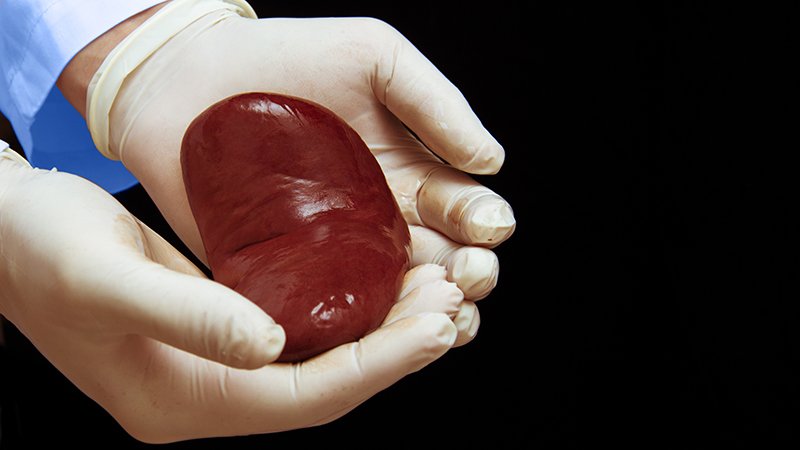
Dr Chirag Parikh
The availability and procurement of kidneys from deceased donors with stage 3 acute kidney injury (AKI) has increased in recent years, yet despite strong evidence of their viability, high rates of AKI kidneys are still discarded, suggesting the need for changes in how those kidneys are scored in the Kidney Donor Profile Index (KDPI), the authors of new research assert.
“This is a half-glass-full or half-glass-empty situation,” senior author Chirag Parikh, MBBS, PhD, director of the division of nephrology at Johns Hopkins University School of Medicine, in Baltimore, Maryland, said in a press statement.
“Optimistically, you can look at it as we’re transplanting more kidneys because we are harvesting 2000 more, yet we’re still discarding 44% of stage 3 kidneys,” he added. “We can do better and wipe out this kidney transplant shortage just by using AKI kidneys.”
A Change in Donor Scoring System Needed
Placing much of the blame on the unintended “labeling effect” of the KDPI, which can give the false impression that AKI kidneys are at a high risk for poor outcomes, Parikh is calling for changes to the ways those kidneys are scored.
Specifically, the scores should consider donors’ baseline, instead of terminal, serum creatinine (SCr) levels, which can be transient in cases of AKI, he notes.
“We’ve done a lot of the research, the data are there, and now it’s time to act on updating the scoring system,” Parikh said.
Among numerous studies underscoring the viability of kidneys from deceased donors with AKI is a previous study from Parikh’s research team involving more than 6700 deceased donors with AKI that showed no increased risk of graft failure, even in the most severe instances of AKI.
Despite ongoing long waitlists for kidneys, reports show deceased donor AKI to be a strong predictor of kidney discard.
To evaluate how commonly AKI kidneys become available and are discarded, in the new study, published online in December 2021 in the American Journal of Transplantation, Parikh and colleagues turned to US registry DonorNet data from the Organ Procurement and Transplantation (OPTN) system from 2010 to 2020.
They identified 172,410 kidneys that were procured or transplanted from 93,341 deceased donors aged 16 years or older during the time period.
Of the kidneys, 34,984 (20%) were discarded, and more than half of those (17,559) were from AKI donors, defined as having an increase in SCr from admission of ≥ 50% or ≥ 0.3 mg/dL (≥ 4.0 mg/dL or ≥ 200% for stage 3) .
Over the 10-year period, the proportion of kidneys available that were from stage 3 AKI deceased donors increased from 6% (412/6841) in 2010 to 12% (1365/11,493) in 2020.
The procurement of stage 3 AKI kidneys meanwhile increased over the period from 51% to as high as 80%.
However, rather than declining, the discard rate of stage 3 AKI kidneys increased from 41% in 2010 to 44% in 2020.
“This was a surprise,” Parikh told Medscape Medical News. “I expected a decline based on all the work we have done over the last several years.”
Further findings underscored the likely culprit. The study showed the discard rate of AKI kidneys did initially decline from 41% in 2010 to 32% in 2012, however, a subsequent bounce up to 44% corresponded with the introduction of the KDPI system.
The system indexes kidneys based on 10 donor characteristics ranging from donor height and weight and race/ethnicity to history of hypertension and hepatitis C virus infection, and importantly, SCr.
The system “fails to distinguish between transient SCr increases in deceased donors with AKI from those with preexisting chronic kidney disease,” the authors assert.
“This labeling effect may be most evident for KDPI > 85% kidneys since receiving offers for such kidneys requires explicit, written consent from the patient,” they note.
“In fact, most (approximately 70%) high terminal SCr values are from donors with stage 3 AKI — and disproportionately more likely to discarded.”
Increases in Procurement Largely Due to Small Number of Centers
Although the increase in the procurement of stage 3 AKI kidneys is encouraging, the trend likely is largely driven by only a small proportion of “aggressive” transplant centers, the authors add.
The study did show an increase in US-based transplant centers that used stage 3 AKI kidneys over the 10 years from 36% to 56%, however, nearly half of all US transplant centers did not use any stage 3 AKI kidneys in 2020.
“High KDPI scores are one of the major factors [preventing their use],” Parikh said. “Other [reasons] could include a lack of experience with transplanting these kidneys.”
Of note, the rise in the procurement of stage 3 AKI kidneys has coincided with increases in measures to improve their viability, including longer cold ischemia times and greater utilization of kidney hypothermic machine perfusion.
“Broader use of machine perfusion should help with acceptance of these AKI kidneys,” Parikh noted.
More AKI Donor Kidneys Reflect Increased AKI
The upswing in the availability of stage 3 AKI kidneys likely reflects increases in the health factors leading to AKI, including obesity, a circulatory reason for death, sepsis, acute heart failure, and increased rates of cardiac catheterization and mechanical ventilation, the authors explain.
“The incidence of severe AKI among hospitalized patients has been rising and thus the increasing prevalence of AKI among deceased donors is not unexpected,” they note.
Those increases in AKI kidneys further underscore the need for proactive efforts to make use of them, particularly as long waiting lists for kidney transplants persist.
“AKI kidneys have excellent outcomes after transplantation and would be a great resource to benefit recipients on the waiting list,” Parikh said.
Parikh has reported receiving consulting fees from Renalytix and Genfit and grant/research support from the National Institute of Diabetes and Digestion and Kidney Diseases and the National Heart, Lung, and Blood Institute. Disclosures for the other authors are listed in the article.
Am J Transplant. Published online December 12, 2021. Abstract
Follow Medscape on Facebook, Twitter, Instagram, and YouTube.
Source: Read Full Article
